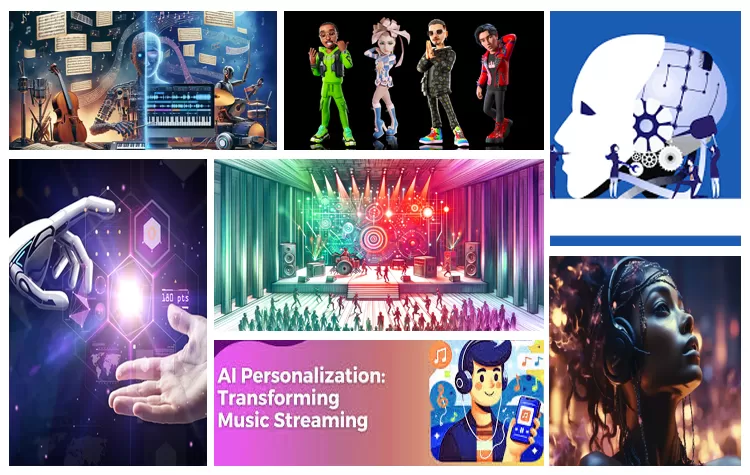With evolving technology, music is highly revolutionized as it now requires more of artificial intelligence and virtual artists. With this development, how people create, consume, and experience music evolves with the boundary expansion of the arts, creativity, and audience interaction. Here's how AI and virtual artists are changing the face of music.
1. AI-Powered Music Composition and Production
AI impacts composing and production in music and even to an extent, on stage. Massive musical data is analyzed to produce fresh, unique work by examining melodies, harmonies, or the rhythms of various music genres. The technology lets musicians create sounds, which can rapidly formulate ideas since this task, if done manually, consumes weeks to actually produce a completed song.
- AI Tools: Applications like Amper Music, Aiva, and OpenAI's Jukebox enable the production of different styles of music. These tools support songwriting, beat-making, and film scoring.
- Collaborative Creation: Artists are now collaborating with AI as a creative partner. AI can make base compositions. It is the human artists who fill in the details using their creative instincts. Thus, machines can be used at optimal efficiency along with human intuition.
2. Virtual Artists and Avatars
These virtual artists, created by means of AI and advanced animation, are now increasingly finding a niche in the music industry. They sing and dance like the real ones and can also deal with fans at various levels. Virtual artists may perform any time, look whatever way, and never age.
- Examples: Hatsune Miku is a Japanese powered virtual pop star built upon a vocal synthesizer, one of the most sought-after virtual artists; she performs in hologram form before a living audience. More recently, AI-generated artists such as FN Meka, and virtual influencers like Lil Miquela, have also been popularized.
- Industry Impact: Virtual artists give record labels and producers greater control over the image and music associated with these characters while enjoying the capability to reach the world market without performance geographical constraints.
3. AI-Driven Personalization of Music Streaming
Spotify and Apple Music are using AI algorithms for the content streams in music streaming. They review the activities of the users and their preferences to compile mixed playlists that introduce new music based on an individual's tastes.
- Algorithmic Playlists: Such features include Spotify's Discover Weekly and Daily Mix, which use AI to curate music around the user's past listening habits and the trending sounds of the times.
- Emotion-Based Recommendations: Future AI systems would make appropriate recommendations, considering the emotional state of a user; data would be taken from wearable devices or through user input to create the right playlist for a listener's current mood.
4. AI in Live Music and Performance
AI is transforming live music in performances, in the sense of improving performances through real-time sound design, visual effects, and stage design. Concerts, being interactive and immersion events, start to offer a futuristic experience to fans.
- Virtual Concerts: AI-powered virtual concerts by Travis Scott or Ariana Grande in Fortnite are an example of this kind of potential. Once VR and AR technologies improve, AI will help create totally immersive concerts that can be accessed from anywhere in the world.
- Interactive Experiences: AI might also create an interactive concert experience by which a fan would be able to interact with AI avatars or influence performances through social media or gaming platforms, deepening his relationship with the artist.
5. AI and Music Video Creation
AI also revolutionizes the music video; for example, it lets one edit or animate in real time or use deep fake technology. It will further let artists add hyper-realistic or surreal visuals that would match the setting of their song in unheard-of ways and from a new point of view, adding a new dimension to music storytelling.
- Visual Creativity: AI-generated visuals can be dynamic to the music, thus introducing new realms in the experimentation of artists with dynamic music videos that change with the beat or mood.
- Deepfakes and Virtual Avatars: AI deepfake technology will open new avenues for virtual recreations of artists or new characters in infinite virtual performances and creative storytelling.
6. Ethical Considerations and Challenges
And so, as the role of AI seems to take over a large part of the music industry, questions pop up on originality, ownership, and the position of a human musician in the future.
- Copyright and Ownership: who owns the rights to music created with AI is another question-and also who might justly claim ownership-of the music: the user of the software, the company that developed the AI, or perhaps it should be chucked into the public domain? The music industry will need to provide some guidelines for this.
- Job Displacement: The actual creation of music by AI poses a threat to work opportunities for session musicians, composers, and producers. There will be the need to make sure that there is an integration of human artistry and AI-originated content in order not to compromise livings within the industry.
7. The Future Outlook: Human and AI Collaboration
Maybe the most promising area in the future of music is more integration of human and AI collaboration. It seems that AI machines have a natural ability to identify patterns and make innovations in data processing that no human can do faster than the machine. However, musicians will provide emotions and authenticity beyond machines' capabilities. Thus, rather than performing the function of replacing human musicians, AI is likely to be a tool meant to elicit creation and extend musical exploration possibilities.
Conclusion
The very future of music is on the threshold of drastic change: from AI and virtual artists to composition with the help of AI, streaming according to personal preference, virtual performances, and video clips. All this is unlocked by technology for creativity and connection with an audience. And the more these innovations develop, the more collaborative, experimental, and immersed in the music industry it will be.
